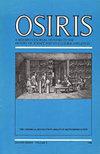武装的算法
IF 1
3区 哲学
Q2 HISTORY & PHILOSOPHY OF SCIENCE
引用次数: 0
摘要
人工智能(AI)和机器人技术的历史往往忽视了物理结构对塑造其相互构成的进化的代码是如何至关重要的。这篇文章通过绘制麻省理工学院和斯坦福大学的人工智能界在20世纪60年代末和70年代初如何在被称为微世界的校准构建环境中实验“武装算法”(与计算机接口的机械臂)来探索这些关系。这些人造空间旨在过滤现实世界中的噪音和顽固不化,这使得机器人实验变得极其困难。除了实验室或科学价值之外,微观世界还积极展示了相互定位,这反过来又递归地推动了技术科学冷战世界的相互构建。因此,为了让他们的武装算法发挥作用,128号公路和硅谷的技术人员不仅入侵了他们的计算机,还入侵了物理和社会世界,以推动人工智能和机器人技术的前沿发展。本文章由计算机程序翻译,如有差异,请以英文原文为准。
Armed Algorithms
Histories of artificial intelligence (AI) and robotics often overlook how physically crafted structures were crucial to the code that shaped their mutually constitutive evolution. This article explores these relationships by charting how the artificial intelligentsia at MIT and Stanford experimented with “armed algorithms”—robot arms interfaced to computers—in calibrated built environments, called microworlds, during the late 1960s and early 1970s. These manufactured spaces were designed to filter out the noise and recalcitrance of the real world that made robotic experimentation exceedingly difficult. Beyond their laboratory or scientific value, the microworlds also served as positive demonstrations of mutual orientation, which in turn recursively drove the mutual construction of the technoscientific Cold War world. To make their armed algorithms work, therefore, technologists on Route 128 and in Silicon Valley hacked not only their computers but also the physical and social world to push forward the frontiers of AI and robotics.
求助全文
通过发布文献求助,成功后即可免费获取论文全文。
去求助
来源期刊

Osiris
管理科学-科学史与科学哲学
CiteScore
1.10
自引率
0.00%
发文量
18
审稿时长
>12 weeks
期刊介绍:
Founded in 1936 by George Sarton, and relaunched by the History of Science Society in 1985, Osiris is an annual thematic journal that highlights research on significant themes in the history of science. Recent volumes have included Scientific Masculinities, History of Science and the Emotions, and Data Histories.
 求助内容:
求助内容: 应助结果提醒方式:
应助结果提醒方式:


